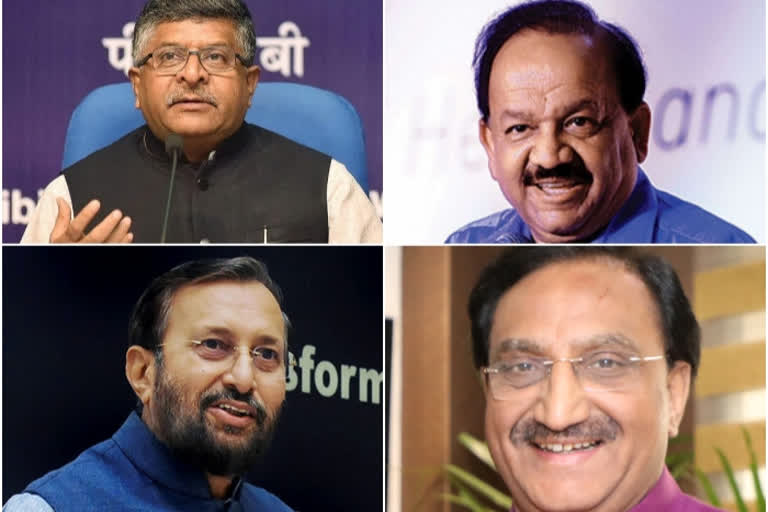New Delhi: “Hum saat(h) saat(h) hai” may well be the ‘tambola’ call for ‘77’ in a friendly neighbourhood birthday party, but that was the number of ministerial inductees in the jumbo-size expansion carried out on Wednesday, indicative of carrying everyone along with eyes on ‘Elections 2024’.
The huge change comprised 48—a whopping 62 percent ministers—who hailed from the OBC, SC or ST communities. With these three categories forming about 66 percent of the country’s population, the ministerial change has an obvious populist dimension.
The average age of the council of ministers has also slid by three years from 61 years to 58 years while the average age of the 44 newly-sworn in ministers is 56 years.
Clearly, the ‘old’ guard has given way to the ‘new’.
What was surprising was the dropping of a few seniors considered political heavyweights in their own right like Ravi Shankar Prasad, Prakash Javadekar, Harshvardhan and Santosh Gangwar. Significantly, from the old guard more than two decades back with Atal Behari Vajpayee at the helm, only Rajnath Singh and Mukhtar Abbas Naqvi remain.
Others dropped included Ramesh Pokhriyal Nishank, D V Sadananda Gowda, Thaawarchand Gehlot and Babul Supriyo.
Also read: 36 highly learned professionals find place in Modi 2.0 cabinet
Significance and Implications:
One, the surprise dropping of law and justice and IT minister Ravi Shankar Prasad may be seen as a move to mollify the US government, the West and social media giants like Twitter and others with whom the government has had face-offs on quite a few occasions. Moreover, the law abrogating Article 370, banning the Internet in Kashmir, enactment of the Citizenship Amendment Act etc has not been taken very kindly by the US and the West.
The Joe Biden led US-regime has also begun training its focus on rights issues. With the issue expected to garner more attention in the new future, more so, after the recent passing away of tribal rights activist Father Stan Swami, easing out Prasad could be an easy way out if only to muffle severe opposition. This will make for a conducive atmosphere before the PM undertakes the planned visit to the US by the year-end.
Two, the dropping of health minister Harshvardhan and his deputy minister Ashwani Chaubey is indicative of the fact that the management and handling of the deadly second wave of the Covid pandemic has the potential of turning into a hot issue in the forthcoming Uttar Pradesh state elections.
Three, the Dr S Jaishankar-headed Ministry of External Affairs now has three junior ministers. Besides V Muraleedharan, two more were sworn in yesterday—Meenakshi Lekhi and Rajkumar Ranjan Singh—signifying the expansive and vital role the ministry will have to play in the coming days. In fact, foreign policy has acquired significance in the government after a very long time.
"After the Bangladesh war in 1971 and the period immediately preceding it, this is by far the most critical period for foreign policy for India. The role that India seeks to play in the region because of its size and heft, the will to counter a rising China, the obstacles to its ambitions, the LoC (de-facto border with Pakistan), LAC (de-facto border with China), West Asia all are posing serious challenges, the need to firm up relations with US and EU. That has found reflection in the new addition of junior ministers in the MEA,” says Prof Kumar Sanjay Singh, a keen follower of global strategies who teaches history at a Delhi University college.
Also read: PM Modi Cabinet 2.0: New Ministers get to work
Four, the induction of Ashwini Vaishnav, a former IAS officer and a BJP Rajya Sabha member from Odisha, who is known to be close to Naveen Patnaik, Odisha CM and Biju Janata Dal supremo, is significant. It is meant to blunt the move by opposition parties to unite as a common front against the BJP.
Five, similarly, the induction of Narayan Rane puts paid to all hopes of a rapprochement between the BJP and the Shiv Sena in Maharashtra. As is known, there is no love lost between Rane and Uddhav Thackeray.
In fact, the belligerence may already be showing with Rane saying on Thursday while taking charge as a minister in the Micro, Small and Medium Enterprises (MSME) ministry that Maharashtra CM Udhhav Thackeray lacks the large-heartedness even to congratulate him (Rane) on assuming the new post.
Six, the latest ministerial expansion has seen the biggest presence from the traditionally under-represented Northeast region till date. There are five ministers from the region, representing four of the region’s seven states.
While Kiren Rijiju (Law and Justice) and Sarbananda Sonowal (Shipping, Ports and Waterways and Ayush) are full-fledged cabinet ministers, Rameshwar Teli (Petroleum and Natural Gas and Labour and Employment), Dr RK Ranjan Singh (MEA) and Pratima Bhoumik (Social Justice and Empowerment ministry) are the three junior ministers.
With the picture not exactly being a rosy one for the BJP and its allies in the 2024 parliamentary polls, the party may see erosion in its support base in western Uttar Pradesh, Punjab and parts of Rajasthan due to the enactment of the controversial farm laws.
The party therefore is sparing no effort to strike a solid foundation in the Northeast which sends back 25 MPs to the Lok Sabha. At the moment, the BJP has 14 seats. (END)



